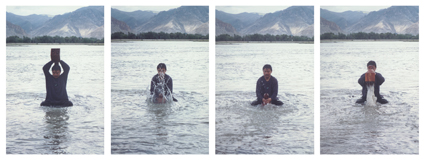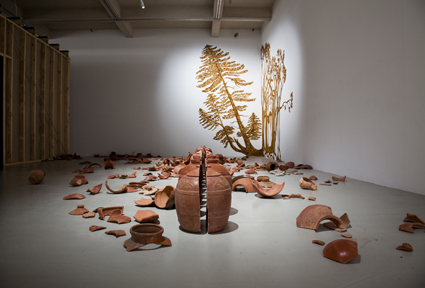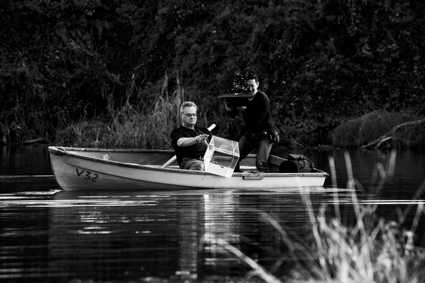opposing currents
ella mudie: the river project

Song Dong, Stamping the Water 1996
courtesy the artist and Beijing Commune
Song Dong, Stamping the Water 1996
RIVERS EVOKE JOURNEYS AND A SENSE OF PASSAGE. ON A QUIET SUNDAY MORNING AT THE CAMPBELLTOWN ARTS CENTRE, IT WAS THE GRINDING WHIR OF A MOTOR THAT FIRST DREW ME TOWARD JUN NGUYEN-HATSUSHIBA’S HALLUCINATORY TRIPARTITE FILM, THE GROUND, THE ROOT AND THE AIR (2004-07).
I soon found myself transported to Laos as I followed a flotilla of boats carrying art students painting at their easels, gliding down the Mekong, the brisk pace of the boats and the amplified volume of their engines at odds with the slow and tranquil activity of making art. The contradiction alluded to the ways modernity can run in opposing currents to tradition and was just one of the many explorations into the psychological and physical terrain of the river that visitors were invited to undertake at the Arts Centre’s latest exhibition, The River Project.
In fact, the notion of opposing currents offers an apt avenue into not only The River Project but also the debate over waterways generally, as the current difficulties the Murray Darling Basin Authority faces in negotiating competing economic and environmental demands clearly demonstrate. The River Project didn’t deal specifically with this river system: however it did take the Campbelltown Upper Georges as its starting point, then extended its reach to arteries throughout the Asia-Pacific from China, Korea, the Philippines and India, to Vietnam, Papua New Guinea and Laos, offering a kaleidoscopic view of the diverse factors driving rivers toward crisis point. Yet as much as this interdisciplinary program exhibited a strong environmental conscience, it didn’t feel like an eco art show since curator Binghui Huangfu appeared more concerned with engagement than activism. In this way, most artists departed from literal responses in favour of more open-ended and sophisticated styles of visual poetry, resulting in a surprisingly diverse, nuanced and frequently absorbing program.

Reena Kallat, 2 Degrees
courtesy Campbelltown Art Centre
Reena Kallat, 2 Degrees
Particularly affecting was Reena Kallat’s installation 2 Degrees (2010), which responded to the geopolitical volatility of the Indus River Basin on the border of India and Pakistan where most recently disastrous flooding from severe monsoonal rains cost thousands of lives and rendered over 20 million people homeless. With just a soundtrack of gushing water, a hybrid tree—half Indian Banyan, half Pakistani Deodar—painted directly onto the wall with henna and a row of ceramic vessels seismically split down the middle and marooned in a sea of broken shards, Kallat imaginatively transported the viewer to a flooded riverbank, eliciting empathy via the senses. Drawing the viewer into the aftermath, the installation rendered universal the sense of loss and vulnerability humans experience at the hands of natural disasters as well as the painful divisions that can be forged between nations over water.
The displacement of human communities and natural resources was likewise conjured elliptically in Zhuang Hui’s suite of black and white photographs which depicted geological close-ups of holes in the ground the artist had dug over a decade ago in regions to be affected by the Three Gorges Dam, Longitude 109.88E and Latitude 31.09N (1995, 2008). The holes now deeply submerged, video footage of the Yangtze on the opposite wall pointed to the cause and effect relationship, the void in between creating an air of elegy and melancholia. Vietnamese artist Tiffany Chung, meanwhile, responded to annual flooding of the Mekong with varying degrees of light and shade in a series of five topographic maps including one charming mixed media work that mapped the migratory routes of local fish species. Like a spider spinning cobwebs across a canvas, Chung plotted a dense network of sprawling tracks with pearlescent beads, trails of brightly coloured stitching and clusters of silver grommets, offering an optimistic and joyful celebration of the rich diversity of life that abundant water breeds.
Works by Cao Fei, Ringo Bunoan, Minouk Lim and MM Yu among others exhibited a strong focus on Asia. Meanwhile a selection of specially commissioned works by prominent Sydney artists responding to the local landscape reflected the program’s role as a key component of the three-year Upper Georges River Urban Sustainability Project. Indigenous artist Graham ‘Nudge’ Blacklock’s painting The Point, The Georges River (2010) employed highly expressive, radiating brushwork to capture the region’s spiritual resonance while Elisabeth Cummings’ deft, painterly treatment revealed the land’s lyrical beauty to be marred by evidence of subsidence from longwall mining. Along with a suite of cryptic photographs by Bonita Ely that married reportage with more poetic meditations, these works offered aesthetically interesting inroads to discussion, although their location at the entrance, rather than in the main gallery spaces integrated with the international works, made them appear somewhat adjunct.

Mike Parr, Gotaro Uematsu, Pure Water Into Polluted Water 2010, Georges River, performance still
photo Silversalt photography, courtesy the artist and Anna Schwart
Mike Parr, Gotaro Uematsu, Pure Water Into Polluted Water 2010, Georges River, performance still
Given rivers have long symbolised flux and impermanence, the restaging of three seminal performance works was particularly well suited to the exhibition’s theme and highlighted the unstable meanings of performances over time. In addition to Chinese artist Song Dong’s ongoing gesture of writing calligraphy with water, Water Diary (2010), and the repetition of a 1995 action of scrubbing down frozen blocks of polluted water by the Beijing-based Yin Xiuzhen, Washing River (2010), an invitation was also extended to Sydney artist Mike Parr to revisit a performance from 1971, Pure Water into Polluted Water. Initially the action saw Parr drop a plastic bag filled with distilled water into the Georges River to produce a Minimalist-style “hole in nature”; however, when Parr came to revisit the gesture he soon realised the plastic bag had become a too heavily loaded material. To regain some of the gesture’s initial conceptual potency he revisited the action with a clear perspex cube and in an accompanying community discussion noted how this sinking message in a bottle epitomises our psychological problem as humans—“we want to have an effect.”
Community involvement took an unusual turn, too, in the form of a formidable Maori Waka canoe restored and carved by young local job seekers, led by Verdun Walker and Peter T Elers, and moored in one of the gallery’s main spaces amidst an installation of contemporary and traditional art from Papua New Guinea, The Sepik River Project. Something of an exhibition within an exhibition, and one that could warrant its own review, The Sepik River Project was a fascinating exercise in cross-cultural exchange, presenting cultural artefacts acquired by independent curator Dr Susan Cochrane alongside portraits painted by Port Moresby artist Jeffry Feeger on a recent trip to the Sepik River. The pair had in fact navigated their journey along the river by canoe. There were also paintings created by local artists when Feeger and Cochrane gifted the Sepik some contemporary art materials. According to Cochrane, “within two days, some 30 paintings and drawings of Kambot ancestral stories were produced, and the painting session was still going when it was time to leave.”
Making my way out of the gallery, I paused to admire a tableaux of 36 photographs documenting another performance by Song Dong, Stamping the Water (1996). Propped on the surface of the Lhasa River, the artist lifted an archaic wooden seal carved with the Chinese character for water high above his head then plunged it with great physical exertion into the water as if trying, however futile the effort, to imprint the uncontainable. Like Parr’s Pure Water Into Polluted Water, this was an action of conceptual sophistication that also held something of the charm of riddles. It was the slippery, more mysterious and elusive moments like these that arguably proved The River Project’s most compelling. If it lacked anything it was a sense of the fury and passion surrounding contested and polluted waterways; however by engaging the imagination these quietly powerful works revealed how rivers are not only vital natural conduits and givers of life, but also deeply connected to memory, desire, cultural identity, spiritual pilgrimage and mental transformation. When it comes to reasons to get the balance right to ensure their future survival, how many more do we need?
The River Project, curator Binghui Huangfu, Campbelltown Arts Centre, Sydney, Aug 28-Oct 24
RealTime issue #100 Dec-Jan 2010 pg. 42






